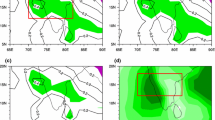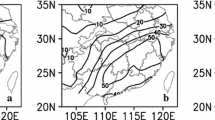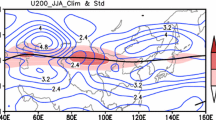Abstract
The climate of the Indian subcontinent is dominated by rainfall arising from the Indian summer monsoon (ISM) during June to September. Intraseasonal variability during the monsoon is characterized by periods of heavy rainfall interspersed by drier periods, known as active and break events respectively. Understanding and predicting such events is of vital importance for forecasting human impacts such as water resources. The Somali Jet is a key regional feature of the monsoon circulation. In the present study, we find that the spatial structure of Somali Jet potential vorticity (PV) anomalies varies considerably during active and break periods. Analysis of these anomalies shows a mechanism whereby sea surface temperature (SST) anomalies propagate north/northwestwards through the Arabian Sea, caused by a positive feedback loop joining anomalies in SST, convection, modification of PV by diabatic heating and mixing in the atmospheric boundary layer, wind-stress curl, and ocean upwelling processes. The feedback mechanism is consistent with observed variability in the coupled ocean–atmosphere system on timescales of approximately 20 days. This research suggests that better understanding and prediction of monsoon intraseasonal variability in the South Asian monsoon may be gained by analysis of the day-to-day dynamical evolution of PV in the Somali Jet.

















Similar content being viewed by others
References
Anderson DM, Brock JC, Prell WL (1992) Physical upwelling processes, upper ocean environment and the sediment record of the southwest monsoon. Geol Soc Lond Special Publ 64(1):121–129
Annamalai H, Slingo JM, Sperber KR, Hodges K (1999) The mean evolution and variability of the Asian summer monsoon: Comparison of ECMWF and NCEP-NCAR reanalyses. Mon Weather Rev 127(6):1157–1186
Bhat GS (2001) Near surface atmospheric characteristics over the North Bay of Bengal during the Indian Summer Monsoon. Geophys Res Lett 28:987–990
Dee DP, Uppala SM, Simmons AJ, Berrisford P, Poli P, Kobayashi S et al (2011) The ERA-Interim reanalysis: Configuration and performance of the data assimilation system. Q J R Meteorol Soc 137(656):553–597
Findlater J (1969) A major low-level air current near the Indian Ocean during the northern summer. Q J R Meteorol Soc 95(404):362–380
Findlater J (1971) Mean monthly airflow at low levels over the western Indian Ocean. Geophys. Mem. No. 115. HMSO, London, 53 pp
Findlater J (1977) Observational aspects of the low-level cross-equatorial jet stream of the western Indian Ocean. Pure appl Geophys 115(5–6):1251–1262
Gadgil S, Joseph PV (2003) On breaks of the Indian monsoon. J Earth Syst Sci 112(4):529–558
Goswami BN (2005) South Asian monsoon. In: Lau WKM, Waliser DE (eds) Intraseasonal variability in the atmosphere-ocean climate system. Praxis Springer, Berlin, pp 19–61)
Goswami BN, Ajayamohan RS (2001) Intraseasonal oscillations and interannual variability of the Indian summer monsoon. J Clim 14:1180–1198
Hart JE, Rao GV, Van De Boogaard H, Young JA, Findlater J (1978) Aerial observations of the East African low-level jet stream. Mon Weather Rev 106(12):1714–1724
Hoskins BJ, Rodwell MJ (1995) A model of the Asian summer monsoon. Part I: the global scale. J Atmos Sci 52(9):1329–1340
Hoskins BJ, McIntyre ME, Robertson AW (1985) On the use and significance of isentropic potential vorticity maps. Q J R Meteorol Soc 111(470):877–946
Izumo T, Montégut CB, Luo JJ, Behera SK, Masson S, Yamagata T (2008) The role of the western Arabian Sea upwelling in Indian monsoon rainfall variability. J Clim 21(21):5603–5623
Jayakumar A, Turner AG, Johnson SJ, Rajagopal EN, Mohandas S, Mitra AK (2016) Boreal summer sub-seasonal variability of the South Asian monsoon in the Met Office GloSea5 initialized coupled model. Clim Dyn. doi:10.1007/s00382-016-3423-x (published online)
Joseph PV, Sabin TP (2008) An ocean–atmosphere interaction mechanism for the active break cycle of the Asian summer monsoon. Clim Dyn 30(6):553–566
Joseph PV, Sijikumar S (2004) Intraseasonal variability of the low-level jet stream of the Asian summer monsoon. J Clim 17(7):1449–1458
Krishnamurthy V, Shukla J (2000) Intraseasonal and interannual variability of rainfall over India. J Clim 13(24):4366–4377
Krishnamurthy V, Shukla J (2007) Intraseasonal and seasonally persisting patterns of Indian monsoon rainfall. J Clim 20(1):3–20
Krishnamurthy V, Shukla J (2008) Seasonal persistence and propagation of intraseasonal patterns over the Indian monsoon region. Clim Dyn 30(4):353–369
Krishnamurti TN, Molinari J, Pan HL (1976) Numerical simulation of the Somali jet. J Atmos Sci 33(12):2350–2362
Krishnan R, Zhang C, Sugi M (2000) Dynamics of breaks in the Indian summer monsoon. J Atmos Sci 57(9):1354–1372
Liebmann B (1996). Description of a complete (interpolated) outgoing longwave radiation dataset. Bull Am Meteorol Soc 77:1275–1277
Maharana P, Dimri AP (2016) Study of intraseasonal variability of Indian summer monsoon using a regional climate model. Clim Dyn 46(3–4):1043–1064
Mandke SK, Sahai AK, Shinde MA, Joseph S, Chattopadhyay R (2007) Simulated changes in active/break spells during the Indian summer monsoon due to enhanced CO2 concentrations: assessment from selected coupled atmosphere–ocean global climate models. Int J Climatol 27(7):837–859
Marshall J, Johnson H, Goodman J (2001) A Study of the Interaction of the North Atlantic Oscillation with Ocean Circulation. J Clim 14:1399–1421
McCreary JP, Kundu PK, Molinari RL (1993) A numerical investigation of dynamics, thermodynamics and mixed-layer processes in the Indian Ocean. Prog Oceanogr 31(3):181–244
Murakami T, Godbole R, Kelkar RR (1970) Numerical simulation of the monsoon along 80°E. In: Proceedings of the Conference on the Summer Monsoon of South East Asia,Norfolk, VA, Navy Weather Research Facility, pp 39–51
Murakami T, Nakazawa T, He J (1984) On the 40–50 day oscillations during the 1979 Northern Hemisphere summer. I: phase propagation. J Meteorol Soc Jpn 62(3):440–468
Naidu CV, Krishna KM, Rao SR, Kumar OB, Durgalakshmi K, Ramakrishna SSVS (2011) Variations of Indian summer monsoon rainfall induce the weakening of easterly jet stream in the warming environment? Global Planet Change 75(1):21–30
Newell RE, Kidson JW, Vincent DG, Boer GJ (1974) General circulation of the tropical atmosphere and interactions with extratropical latitudes, vol 2 (No. COO-2195-16). Massachusetts Institute of Technology Press, Cambridge, MA Volume
O’Callaghan A, Joshi M, Stevens D, Mitchell D (2014). The effects of different sudden stratospheric warming types on the ocean. Geophys Res Lett. doi:10.1002/2014GL062179
Premkumar K, Ravichandran M, Kalsi SR, Sengupta D, Gadgil S (2000) First results from a new observational system over the Indian seas. Curr Sci 78(3):323–330
Rajeevan M, Bhate J (2009) A high resolution daily gridded rainfall dataset (1971–2005) for mesoscale meteorological studies. Curr Sci 96(4):558–562
Rajeevan M, Bhate J, Kale JD, Lal B (2006) High resolution daily gridded rainfall data for the Indian region: analysis of break and active monsoon spells. Curr Sci 91(3):296–306
Rajeevan M, Gadgil S, Bhate J (2010) Active and break spells of the Indian summer monsoon. J Earth Syst Sci 119(3):229–247
Ramesh KV, Krishnan R (2005) Coupling of mixed layer processes and thermocline variations in the Arabian Sea. J Geophys Res 110:C05005. doi:10.1029/2004JC002515
Rodwell MJ (1997) Breaks in the Asian monsoon: the influence of Southern Hemisphere weather systems. J Atmos Sci 54(22):2597–2611
Rodwell MJ, Hoskins BJ (1995) A model of the Asian summer monsoon. Part II: cross-equatorial flow and PV behavior. J Atmos Sci 52(9):1341–1356
Sengupta D, Ravichandran M (2001) Oscillations of Bay of Bengal sea surface temperature during the 1998 summer monsoon. Geophys Res Lett 28(10):2033–2036
Shenoi SSC, Shankar D, Shetye SR (2002) Differences in heat budgets of the near-surface Arabian Sea and Bay of Bengal: implications for the summer monsoon. J Geophys Res Oceans 107(C6):1–14. doi:10.1029/2000JC000679
Slingo J,Spencer H,Hoskins B, Berrisford P, Black E (2005) The meteorology of the Western Indian Ocean, and the influence of the east African highlands.. Philos Trans R Soc Lond A 363:25–42
Sperber KR, Slingo JM, Annamalai H (2000) Predictability and the relationship between subseasonal and interannual variability during the Asian summer monsoon. Q J R Meteorol Soc 126(568):2545–2574
Turner AG, Annamalai H (2012) Climate Change and the South Asian summer monsoon. Nat Clim Change 2:587–595
Vecchi GA, Harrison DE (2002) Monsoon breaks and subseasonal sea surface temperature variability in the Bay of Bengal. J Clim 15(12):1485–1493
Vialard J, Jayakumar A, Gnanaseelan C, Lengaigne M, Sengupta D, Goswami B (2011) Processes of 30–90 days’ sea surface temperature variability in the northern Indian Ocean during boreal summer. Clim Dyn 38(9–10):1901–1916
Webster PJ, Magana VO, Palmer TN, Shukla J, Tomas RA, Yanai MU, Yasunari T (1998) Monsoons: Processes, predictability, and the prospects for prediction. J Geophys Res Oceans 103(C7):14451–14510
Xavier PK, Marzin C, Goswami BN (2007) An objective definition of the Indian summer monsoon season and a new perspective on the ENSO–monsoon relationship. Q J R Meteorol Soc 133(624):749–764
Yang DS, Krishnamurti TN (1981) Potential vorticity of monsoonal low-level flows. J Atmos Sci 38(12):2676–2695
Acknowledgements
The first author acknowledges Council of Scientific and Industrial Research (CSIR) funding for Junior Research Fellowship. A. G. Turner is supported in this work by the core grant to the National Centre for Atmospheric Science and as part of the NERC-funded INCOMPASS project NE/L01386X/1. M. Joshi acknowledges support of UK-NERC project NE/L013827/1 (BoBBLE: Bay of Bengal Boundary Layer Experiment).
Author information
Authors and Affiliations
Corresponding author
Rights and permissions
About this article
Cite this article
Rai, P., Joshi, M., Dimri, A.P. et al. The role of potential vorticity anomalies in the Somali Jet on Indian Summer Monsoon Intraseasonal Variability. Clim Dyn 50, 4149–4169 (2018). https://doi.org/10.1007/s00382-017-3865-9
Received:
Accepted:
Published:
Issue Date:
DOI: https://doi.org/10.1007/s00382-017-3865-9




